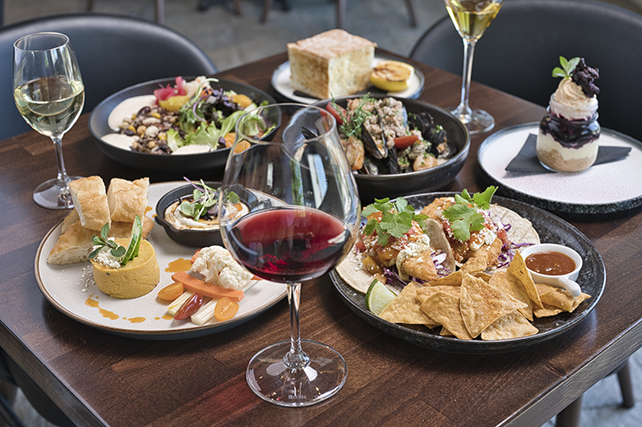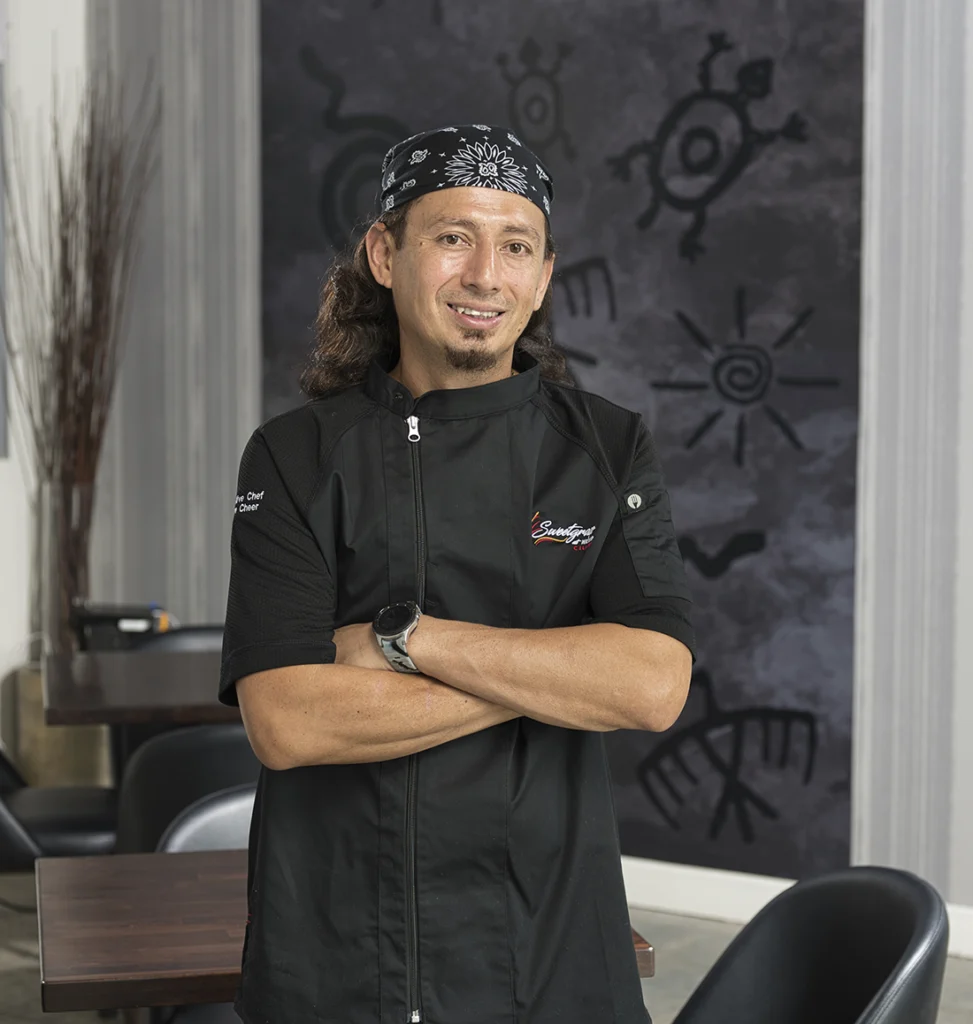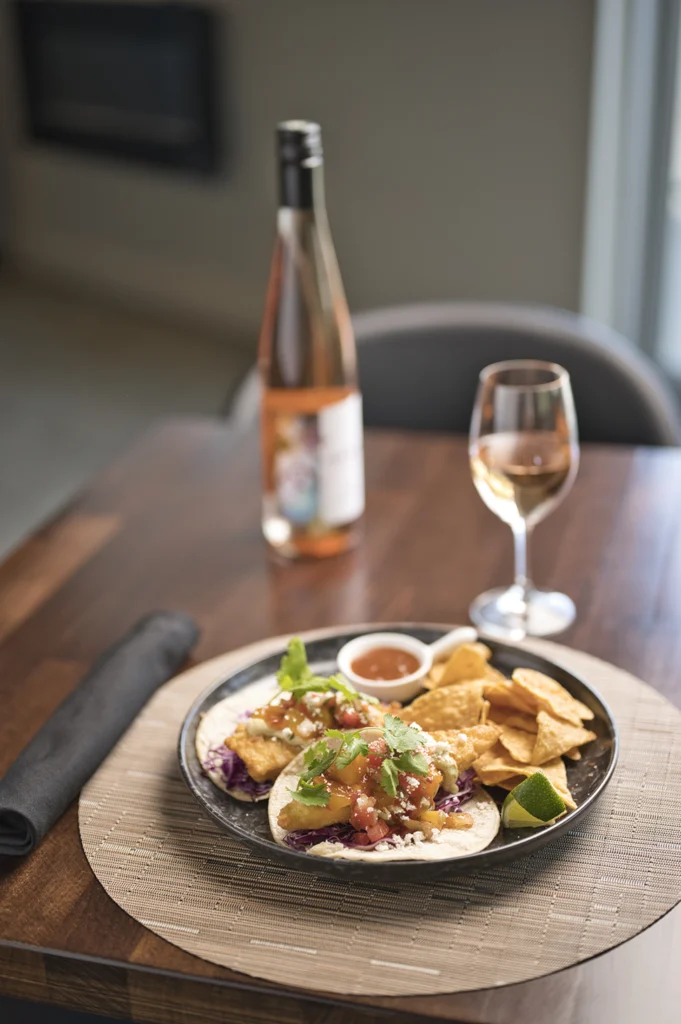When you meet Executive Chef Shawn Cheer, there’s no denying his warmth and charm. And it’s apparent in his approach to food in the newly inspired Sweetgrass at Nk’Mip Cellars restaurant, where the region’s Indigenous culture is not only embraced, it shines.
Every dish tells a story, is a journey through the region’s ancestral heritage and is aimed at showing respect for the land and its bounty.
Though Cheer himself doesn’t hail from British Columbia or even Canada, he is all too familiar with the significance of its Indigenous traditions and practices. That’s because as a native Fijian, he was immersed in his mother’s iTaukei culture and knows the importance of preserving and celebrating one’s ancestral roots.
“The culture is so similar,” Cheer says. “For example, we do fry bread here. Back in Fiji, we call it babakau, but it’s pretty much the same. Like the Indigenous people of Canada, we make the best use of and honour what is available to us.”
The restaurant is named for a sacred herb that symbolizes healing, peace and spirituality and sweetgrass is used to brine the turkey for one of the signature dishes. Other traditional foods such as haskap and Saskatoon berries, rabbit, bison, wild rice, corn and duck are featured on the menu.




The Guide to Dining Out in the Okanagan asked Chef Cheer to share his thoughts on the menu, his food philosophy, restaurant trends and what diners can look forward to at Sweetgrass.
Q: What kind of experience can customers expect when they dine at the restaurant?
Cheer: Customers can expect an experience that’s warm, grounded and full of flavour. Our menu blends Indigenous traditions with locally sourced ingredients from the Okanagan. Every dish is a story, rooted in cultural knowledge, presented with a current trend of food to make it approachable.
Our Three Sisters Bowl for example is inspired by the traditional Indigenous concept of corn, beans and squash. This represents the core of the Three Sisters planting method, which has sustained Indigenous communities across North America for centuries. This is paired with wild rice, squash creamer, house-made pickles and local greens and vegetables for that freshness.
Q: What will diners get that they can’t get anywhere else?
Cheer: A unique fusion of Indigenous and modern cuisine. Using ingredients that are often wild and gamey or seasonally grown in the region. Whether it’s a rabbit pie or crispy duck wings glazed with wild herb hot honey or just a turkey and brie sandwich with haskap berry compote. This, I would say, is different.
Q: What are your signature dishes?
Cheer: Duck wings – crispy wings glazed in our wild herb hot honey; Bison meatballs – Saskatoon berry glaze, feta with taro crisps and fry bread; Mussels – prawns, Italian sausage, chardonnay dill cream sauce and crispy capers; Sweetgrass custard – haskap berry compote and short bread crust.
Q: What advantages and challenges are there to working in the culinary field in the Okanagan?
Cheer: The Okanagan is incredibly rich in local produce, wild ingredients and a strong network of growers, which is a huge advantage, especially for a restaurant with Indigenous fusion cuisine. There’s a genuine appreciation here for seasonal, sustainable food and the culinary community is supportive.
The challenges I have are sourcing certain Indigenous ingredients or wild meats, it consistently can be difficult due to availability or regulations. Staffing is another ongoing issue, every year brings turnover, with people changing career paths or struggling to find housing in the region. Accommodation remains a problem for attracting and retaining talent.
Q: How would you describe the restaurant’s food philosophy and style?
Cheer: Our philosophy is built on respect, heritage and ingredients. We honour Indigenous food traditions while trying to blend it into our modern-day cuisine. The food can be bold and rustic but we try to balance it. Like I said our plates have a story or cultural meaning while trying to add seasonal ingredients.
Q: What part does social media play for the restaurant?
Cheer: I want people to understand and know the meaning behind our dishes and our menu. Social media is so important as this is the way to get it out there, hoping to make people interested in coming down and trying what we have to offer.
Q: What food or industry trends are you seeing emerge?
Cheer: There’s a meaningful rise in demand for locally sourced fresh ingredients, more so than ever Canadian products. People like to know where your meat or seafood is sourced from. How it’s cooked and what type of oil is used. Power food is also the other trend that’s emerging.
Q: How has the culinary industry changed in the past five years?
Cheer: I think more customers are growing open to exploring new cuisines and flavours and embracing more adventurous eating habits.
Q: What role does sustainability play in the restaurant’s approach to food?
Cheer: Sustainability is everything we do. We minimize food waste and focus on ethical sourcing. Many of our ingredients are wild, seasonal, or locally grown while still putting out the best dining experience.
Q: Where does the culinary team draw inspiration when creating new dishes?
Cheer: Our Inspiration comes from many places – family traditions, Indigenous wisdom and even community and staff conversations. We always try to connect flavours with meaning.
by Julianna Hayes
Photography by Lionel Trudel

